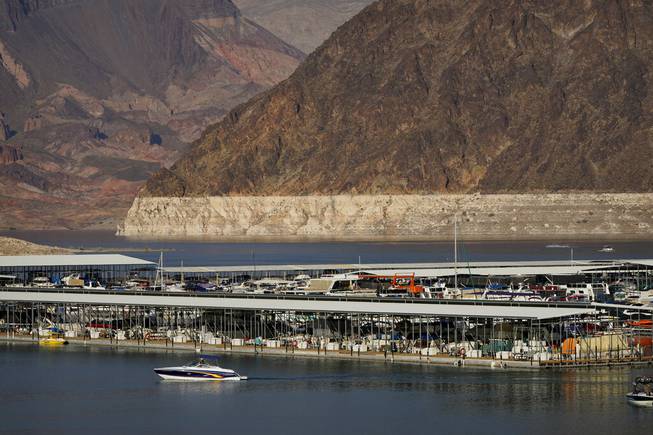
John Locher / AP
A bathtub ring of light minerals delineates the high water mark on Lake Mead at the Lake Mead National Recreation Area, Thursday, Aug. 13, 2020, near Boulder City.
Thursday, Sept. 10, 2020 | 2 a.m.
View more of the Sun's opinion section
On the Nevada side of the Hoover Dam, looking downstream at the Colorado River, are the Winged Figures of the Republic — giant bronze statues that stoically remind us of the seemingly otherworldly forces required to control nature. The two 30-foot sculptures of herculean physiques chiseled with the gift of flight are not just a monument to the creations we’ve imposed upon the once-mighty Colorado River. They are a reminder of humanity’s limits too.
As the Colorado River continues to shrink and demand for water in the West increases, a dangerous proposal to suck water out of Lake Powell requires all of us to ask ourselves an important question: Can Mother Nature endure the will of humanity and still provide for us all?
Right now, water officials in Utah are working at breakneck speed to ram and jam a water-sucking pipeline project through a federal environmental review that will likely set up a crash course between the wills of Mother Earth and mankind.
The project does not have Nevada’s consent, but we are likely to feel its effects. Lake Powell Pipeline would remove 28 billion gallons annually from the Colorado River, diverting water from the upstream reservoir and sending it down to green lawns and golf courses in St. George, Utah.
At a time when every drop of the Colorado is already accounted for, the desire to take more out of an overtaxed river just doesn’t add up. But water officials throughout Utah want to get a seal of approval on this project before 2021 and are hoping that the Bureau of Reclamation will make that happen. This week marks the end of a public comment period on the environmental review that will now kick-start the endgame.
The fatal flaw in the Bureau of Reclamation’s analysis was that it failed to study how conservation could eliminate the need for the project and preserve St. George’s main water source, the Virgin River.
The Bureau of Reclamation’s review also failed to consider effects on Lake Mead’s levels, water quality and wildlife. It was as if Lake Mead and Lake Powell had no connection to one another. The icing on top was that there was no meaningful analysis on the amount of water the Colorado River has lost in the past 100 years and the water it is likely to lose via drought in climate change during the next 100 years.
Southern Nevada, which gets 90% of its water from the Colorado River, knows what it is like to have one major water supply that’s evolving with drought, climate change and economic growth.
Fortunately, the Southern Nevada Water Authority has cut the Silver State’s Colorado River consumption by 26% in the last two decades even while the regional population doubled. It cut in half the gallons per capita per day residents used. It invested in a world-class turf removal program and imposed a host of restrictions for residential and commercial water use.
St. George is doing none of the above. The community is one of the worst water wasters in the U.S. — consuming more than double the gallons per capita of Las Vegas, ignoring commonsense conservation techniques and betting big on a multibillion-dollar project that might not deliver the water it wants.
What’s amazing is that Southern Nevada is not an outlier. Phoenix, Denver, Tucson, Ariz., and Albuquerque, N.M., all consume half the per capita amount of water of St. George in a given day.
The conservation playbook is there for St. George.
Officials, grassroots activists and concerned citizens across Nevada are not sitting idly by. But as we do the work to push back, we are all shaking our heads at Utah. The truth is simple: If Utah gets what it wants, it will only be a Pyrrhic victory.
While the Winged Figures of the Republic represent 20th-century America’s industrial might, I hope the bathtub rings at Lakes Mead and Powell don’t wind up representing the futility and ignorance of entities that didn’t want to do the right thing in the 21st century.
Kyle Roerink is executive director of the Great Basin Water Network, a nonprofit organization dedicated to protecting water resources in the nation’s driest places. He is a former Sun staff reporter.
